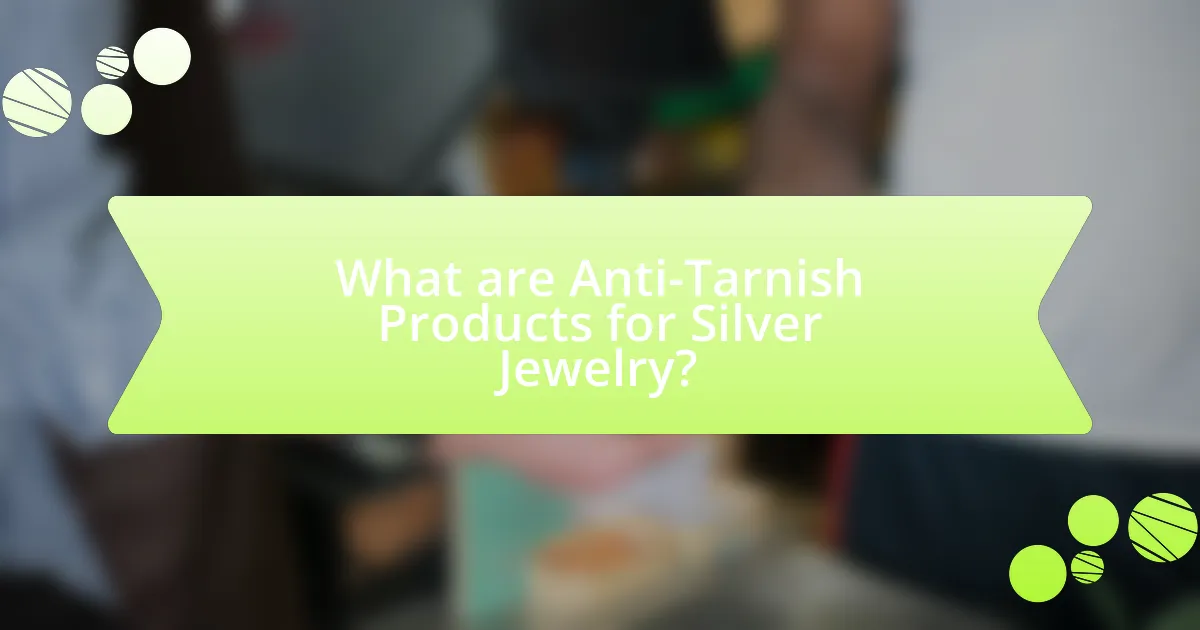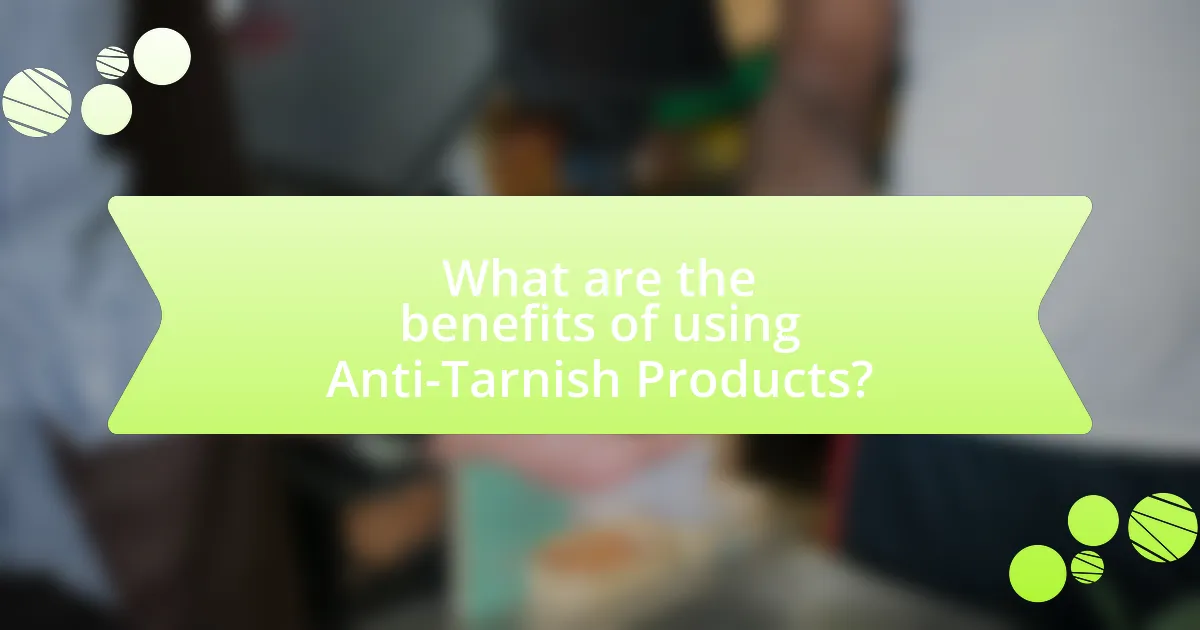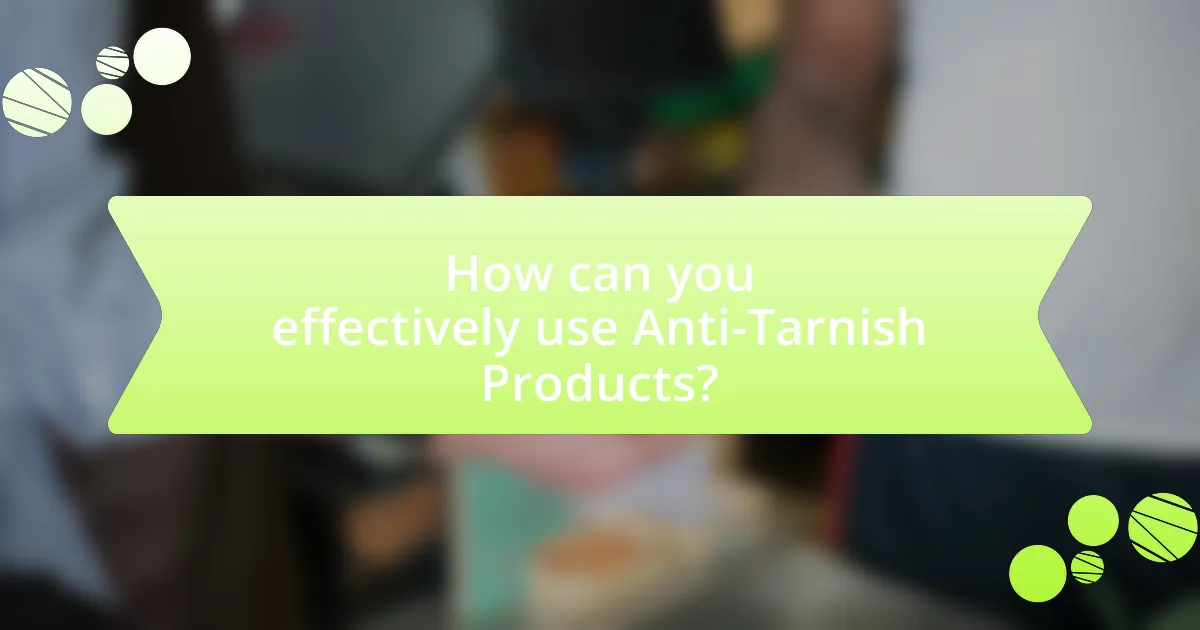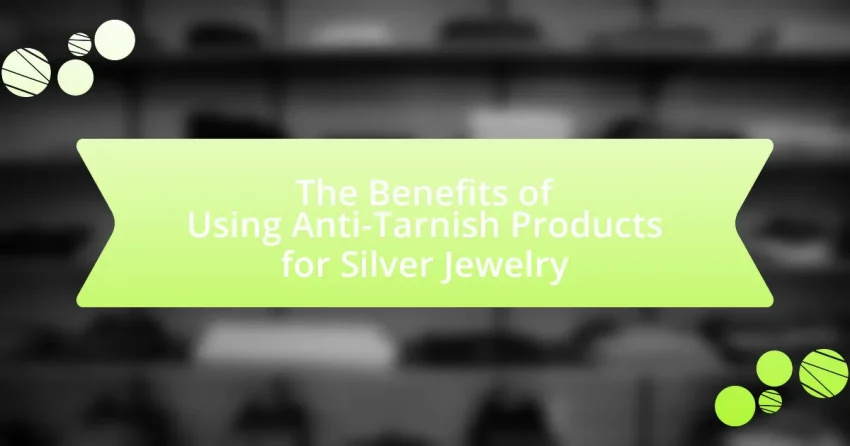Anti-tarnish products for silver jewelry are specialized treatments that prevent or slow down tarnishing caused by the reaction between silver and sulfur compounds in the air. These products, which include anti-tarnish cloths and coatings, create a protective barrier that inhibits oxidation, thereby preserving the jewelry’s shine and extending its lifespan. Key ingredients such as thiol compounds and corrosion inhibitors play a crucial role in this process. The article explores the causes of tarnishing, the benefits of using anti-tarnish products, and best practices for application, emphasizing their importance in maintaining the aesthetic appeal and value of silver jewelry.

What are Anti-Tarnish Products for Silver Jewelry?
Anti-tarnish products for silver jewelry are specialized treatments designed to prevent or slow down the tarnishing process that occurs when silver reacts with sulfur compounds in the air. These products often contain chemical agents, such as anti-tarnish coatings or absorbers, that create a protective barrier on the surface of the silver, thereby minimizing exposure to tarnishing elements. For example, products like anti-tarnish cloths are infused with these agents, allowing users to clean and protect their jewelry simultaneously. The effectiveness of these products is supported by their widespread use in the jewelry industry, where maintaining the aesthetic appeal of silver items is crucial for consumer satisfaction.
How do Anti-Tarnish Products work?
Anti-tarnish products work by creating a protective barrier on the surface of silver jewelry that prevents oxidation and tarnishing. These products often contain chemicals, such as anti-tarnish agents, that inhibit the reaction between silver and sulfur compounds in the air, which are primarily responsible for tarnishing. For example, some anti-tarnish solutions include microcrystalline wax or specialized coatings that bond to the metal, effectively blocking exposure to moisture and air. This protective layer can significantly extend the lifespan of silver jewelry by reducing the frequency of tarnish formation, as evidenced by studies showing that treated silver retains its shine longer than untreated pieces.
What are the key ingredients in Anti-Tarnish Products?
The key ingredients in anti-tarnish products typically include thiol compounds, such as benzotriazole, and other corrosion inhibitors like calcium carbonate and sodium bicarbonate. These ingredients work by forming a protective barrier on the surface of silver, preventing oxidation and tarnishing. Benzotriazole, for instance, is known for its effectiveness in preventing silver tarnish by inhibiting the reaction between silver and sulfur compounds in the air.
How do these ingredients prevent tarnishing?
Anti-tarnish ingredients prevent tarnishing by forming a protective barrier on the surface of silver, which inhibits the oxidation process that leads to tarnish. These ingredients, such as anti-tarnish coatings or chemical compounds like thiol-based agents, react with silver to create a layer that blocks moisture and sulfur compounds from coming into contact with the metal. For example, studies have shown that coatings containing specific polymers can significantly reduce the rate of tarnishing by up to 90% over time, demonstrating their effectiveness in preserving the appearance of silver jewelry.
Why is tarnishing a concern for silver jewelry?
Tarnishing is a concern for silver jewelry because it leads to discoloration and degradation of the metal’s appearance. Silver reacts with sulfur compounds in the air and moisture, forming silver sulfide, which causes the characteristic darkening. This tarnish not only affects the aesthetic appeal of the jewelry but can also diminish its value over time. Regular maintenance and the use of anti-tarnish products can help preserve the shine and integrity of silver pieces, ensuring they remain visually appealing and retain their worth.
What causes tarnishing in silver jewelry?
Tarnishing in silver jewelry is primarily caused by a chemical reaction between silver and sulfur compounds in the air, leading to the formation of silver sulfide. This reaction occurs more rapidly in humid environments or when silver comes into contact with certain substances, such as sweat, cosmetics, or household chemicals. Studies indicate that even low levels of sulfur in the atmosphere can contribute to tarnishing, as silver is highly reactive to these compounds.
How does tarnishing affect the appearance of silver jewelry?
Tarnishing causes silver jewelry to develop a dull, discolored appearance, often resulting in a dark or yellowish film on the surface. This occurs due to a chemical reaction between silver and sulfur compounds in the air, leading to the formation of silver sulfide. The visual impact of tarnishing can diminish the jewelry’s shine and luster, making it less appealing. Regular exposure to moisture and air accelerates this process, which is why tarnished silver often appears unattractive and may require polishing or cleaning to restore its original beauty.

What are the benefits of using Anti-Tarnish Products?
Anti-tarnish products provide significant benefits for preserving the appearance and longevity of silver jewelry. These products create a protective barrier that prevents the oxidation process, which is responsible for tarnishing. By using anti-tarnish solutions, silver jewelry can maintain its shine and luster for extended periods, reducing the need for frequent cleaning. Studies indicate that regular application of anti-tarnish treatments can extend the life of silver items by minimizing exposure to elements that cause tarnish, such as sulfur and moisture.
How do Anti-Tarnish Products enhance the longevity of silver jewelry?
Anti-tarnish products enhance the longevity of silver jewelry by creating a protective barrier that prevents oxidation and tarnishing. This barrier inhibits the chemical reactions between silver and sulfur compounds in the air, which are primarily responsible for tarnish formation. Studies have shown that silver jewelry treated with anti-tarnish solutions can maintain its shine and luster significantly longer than untreated pieces, often extending their aesthetic appeal and usability for years.
What is the impact of tarnish on the lifespan of silver jewelry?
Tarnish significantly reduces the lifespan of silver jewelry by causing corrosion and deterioration of the metal. When silver tarnishes, it forms a layer of silver sulfide, which can lead to pitting and structural weakness over time. Studies indicate that regular exposure to air and moisture accelerates tarnishing, which can ultimately compromise the integrity of the jewelry. For instance, silver jewelry that is not properly maintained can lose its luster and become unwearable within a few years due to extensive tarnish buildup. Therefore, using anti-tarnish products can help preserve the appearance and longevity of silver jewelry by preventing or slowing down the tarnishing process.
How do these products help maintain the jewelry’s value?
Anti-tarnish products help maintain the jewelry’s value by preventing tarnishing, which can degrade the appearance and desirability of silver pieces. These products create a protective barrier that inhibits the chemical reactions between silver and environmental factors, such as sulfur and moisture, which cause tarnish. By preserving the jewelry’s luster and shine, anti-tarnish products ensure that the pieces remain visually appealing and retain their market value. Studies have shown that well-maintained silver jewelry can retain up to 90% of its original value, compared to tarnished pieces that may lose significant worth due to diminished aesthetic appeal.
What aesthetic benefits do Anti-Tarnish Products provide?
Anti-tarnish products provide significant aesthetic benefits by preserving the shine and luster of silver jewelry. These products create a protective barrier that prevents tarnishing, which can dull the appearance of silver over time. By maintaining the jewelry’s original brilliance, anti-tarnish products enhance its visual appeal, ensuring that pieces remain attractive and eye-catching. Studies have shown that silver jewelry treated with anti-tarnish solutions retains its reflective qualities longer than untreated pieces, thereby supporting the claim that these products effectively enhance the aesthetic value of silver jewelry.
How do these products keep silver jewelry looking new?
Anti-tarnish products keep silver jewelry looking new by forming a protective barrier that prevents oxidation and tarnishing. These products often contain chemicals like thiourea or anti-tarnish agents that inhibit the reaction between silver and sulfur compounds in the air, which are responsible for tarnish. For example, studies have shown that using anti-tarnish pouches or cloths can significantly reduce tarnish formation, maintaining the jewelry’s shine and luster over time.
What role do Anti-Tarnish Products play in preserving shine?
Anti-tarnish products play a crucial role in preserving the shine of silver jewelry by creating a protective barrier that prevents tarnishing. This barrier inhibits the chemical reactions between silver and environmental factors such as sulfur and moisture, which are known to cause tarnish. For instance, products containing anti-tarnish agents like thiol compounds can effectively reduce the rate of tarnishing, thereby maintaining the jewelry’s luster over time.

How can you effectively use Anti-Tarnish Products?
To effectively use anti-tarnish products, apply them directly to silver jewelry to create a protective barrier against tarnishing agents. This application can involve using anti-tarnish cloths, sprays, or dips specifically designed for silver. For instance, anti-tarnish cloths contain chemicals that inhibit oxidation, while sprays can coat the surface to prevent tarnish formation. Regular use, ideally after each wear, enhances the longevity of the protective effect, as silver jewelry is particularly susceptible to tarnishing due to exposure to air and moisture. Studies indicate that using these products can significantly reduce tarnish buildup, maintaining the jewelry’s shine and appearance over time.
What are the best practices for applying Anti-Tarnish Products?
The best practices for applying anti-tarnish products include ensuring the surface of the silver jewelry is clean and dry before application. This step is crucial because any dirt or moisture can hinder the effectiveness of the product. After cleaning, apply the anti-tarnish product evenly using a soft cloth or applicator, ensuring full coverage of the jewelry. Allow the product to dry completely as per the manufacturer’s instructions, which typically enhances its protective qualities. Regular reapplication is recommended, especially for items frequently exposed to air and moisture, as this maintains the protective barrier against tarnishing.
How often should you apply these products to your silver jewelry?
You should apply anti-tarnish products to your silver jewelry every few months, or as needed based on exposure to air and moisture. Regular application helps maintain the shine and prevents tarnishing, which can occur due to oxidation. Studies indicate that silver jewelry can tarnish within a few weeks if not properly cared for, especially in humid environments. Therefore, consistent use of these products is essential for preserving the jewelry’s appearance and longevity.
What methods can be used to ensure even application?
To ensure even application of anti-tarnish products on silver jewelry, methods such as using a soft cloth, spray application, and brush application are effective. A soft cloth allows for gentle, uniform coverage, while spray application ensures a fine mist that can reach intricate details. Brush application provides precision for detailed areas, ensuring that the product is evenly distributed. These methods help prevent uneven tarnishing and maintain the jewelry’s appearance.
What common mistakes should be avoided when using Anti-Tarnish Products?
Common mistakes to avoid when using anti-tarnish products include not properly cleaning the silver jewelry before application, which can trap dirt and oils that promote tarnishing. Additionally, using the wrong type of anti-tarnish product, such as those not specifically designed for silver, can lead to damage or ineffective protection. Failing to follow the manufacturer’s instructions regarding application frequency and method can also reduce the product’s effectiveness. Lastly, storing silver jewelry in non-airtight containers without anti-tarnish properties can negate the benefits of the product, allowing tarnish to develop.
How can improper use affect the effectiveness of these products?
Improper use can significantly reduce the effectiveness of anti-tarnish products for silver jewelry. When these products are not applied according to the manufacturer’s instructions, such as using excessive amounts or failing to allow adequate drying time, their protective qualities can be compromised. For instance, if an anti-tarnish solution is applied too thickly, it may not adhere properly to the silver surface, leading to inadequate protection against tarnishing agents like sulfur and moisture. Additionally, improper storage of treated jewelry, such as exposing it to high humidity or direct sunlight, can further diminish the product’s effectiveness, resulting in tarnish formation despite treatment.
What are the signs of overuse or misuse of Anti-Tarnish Products?
The signs of overuse or misuse of anti-tarnish products include discoloration of the silver, a cloudy or dull appearance, and a residue buildup on the surface. Discoloration often manifests as yellowing or darkening, indicating that the product has reacted adversely with the metal. A cloudy or dull appearance suggests that excessive application has led to a film forming on the jewelry, which can inhibit its shine. Residue buildup is typically a result of applying too much product or not allowing it to dry properly, leading to a sticky or greasy texture. These signs indicate that the anti-tarnish product is not being used as intended, which can compromise the aesthetic and integrity of silver jewelry.
What are some recommended Anti-Tarnish Products for silver jewelry?
Some recommended anti-tarnish products for silver jewelry include anti-tarnish cloths, such as the Sunshine Polishing Cloth, which contains anti-tarnish agents that help prevent tarnishing. Additionally, anti-tarnish strips, like the 3M Anti-Tarnish Strips, can be placed in jewelry boxes to absorb moisture and sulfur, which are common causes of tarnish. Another effective option is the use of anti-tarnish bags, such as the Ziploc Anti-Tarnish Bags, which are designed to keep silver jewelry safe from tarnishing agents. These products are effective because they utilize materials that inhibit the oxidation process, thereby preserving the shine and luster of silver jewelry over time.
Which brands are known for their effective Anti-Tarnish solutions?
Brands known for their effective Anti-Tarnish solutions include 3M, Hagerty, and Weiman. 3M offers a range of anti-tarnish products, including cloths and sprays that utilize advanced technology to prevent tarnishing on silver. Hagerty is recognized for its silver care products, which include anti-tarnish cloths and solutions that protect silver items from oxidation. Weiman specializes in cleaning and protecting silverware with its anti-tarnish formulas, which are designed to maintain the shine and luster of silver. These brands have established credibility in the market through consistent performance and customer satisfaction.
What features should you look for in a quality Anti-Tarnish Product?
A quality anti-tarnish product should contain effective tarnish inhibitors, such as microcrystalline wax or specialized chemicals like thiol compounds, which actively prevent tarnishing on silver surfaces. These inhibitors work by forming a protective barrier that reduces exposure to sulfur and moisture, the primary causes of tarnish. Additionally, a good anti-tarnish product should be non-abrasive to avoid damaging the silver’s finish and should be easy to apply, whether in spray, cloth, or solution form. Products that have been tested for longevity and effectiveness, such as those with a proven track record in consumer reviews or laboratory tests, further validate their quality.
How can you troubleshoot issues with Anti-Tarnish Products?
To troubleshoot issues with anti-tarnish products, first identify the specific problem, such as ineffective tarnish prevention or discoloration of the jewelry. If the product is not preventing tarnish, ensure it is applied correctly and that the jewelry is clean and dry before application. Additionally, check the expiration date of the anti-tarnish product, as expired products may lose effectiveness. If discoloration occurs, assess whether the product is compatible with the metal or if it has reacted with other substances. Proper storage conditions, such as humidity and temperature, should also be evaluated, as high humidity can compromise the effectiveness of anti-tarnish products.
